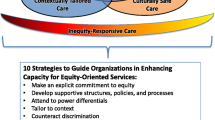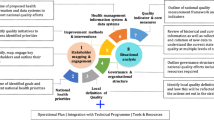Abstract
Background
A quality improvement (QI) focus in systems strategically investing resources to achieve the Quadruple Aim (i.e., better population health, lower system costs, improved patient care, and an engaged and productive workforce) presents an opportunity to reorient health services towards population health promotion.
Setting
An interdisciplinary team linked across a large regionalized healthcare system engaged in a (Saskatoon) Region-wide 90-day QI initiative focused on patient safety.
Intervention
The team worked directly with healthcare teams to link cultural safety, patient-centeredness, and health equity to other dimensions of healthcare quality. The team provided data from health status reports, equity analyses of healthcare utilization, and stakeholder consultations and adapted QI methods, including A3 thinking and Plan-Do-Check-Act (PDCA) cycles.
Outcomes
Throughout the 90 days, use of the terms “health equity” and “cultural safety” increased among healthcare teams and in region-wide communications. Within the year following the initiative, the Region made public and ongoing commitments to address health inequities.
Implications
System-wide QI initiatives present opportunities to promote population health approaches, shift perspectives and language, and ultimately influence organizational culture. Learnings are relevant to health promotion practitioners attempting to engage healthcare partners, and for health systems strategically investing for improved population health.
Résumé
Contexte
Les systèmes axés sur l’amélioration de la qualité (AQ) qui investissent stratégiquement des ressources à la poursuite du « quadruple objectif » (meilleure santé de la population, réduction des coûts du système, soins améliorés, main-d’œuvre engagée et productive) présentent la possibilité de réorienter les services de santé vers la promotion de la santé des populations.
Lieu
Une équipe interdisciplinaire interconnectée au niveau d’un vaste système de soins de santé régionalisé a participé à une initiative d’AQ régionale (Saskatoon) d’une durée de 90 jours portant sur la sécurité des patients.
Intervention
L’équipe a directement travaillé avec des équipes de soins de santé à établir des liens entre la sécurisation culturelle, l’approche centrée sur les patients, l’équité en santé et les autres aspects de la qualité des soins de santé. Les données utilisées provenaient de rapports sur l’état de santé, d’analyses de l’équité dans l’utilisation des soins de santé et de consultations avec les acteurs, et l’équipe a adapté des méthodes d’AQ comme le processus de pensée A3 et le cycle PDCA (penser-démarrer-contrôler-agir).
Résultats
Sur les 90 jours de l’initiative, l’emploi des expressions « équité en santé » et « sécurisation culturelle » a augmenté au sein des équipes de soins de santé et dans les communications régionales. Au cours de l’année suivante, la région s’est engagée publiquement à aborder les inégalités de santé de façon continue.
Implications
Les initiatives d’AQ à l’échelle de systèmes offrent la possibilité de promouvoir des démarches axées sur la santé des populations, de changer les points de vue et le langage et, à terme, d’influencer la culture organisationnelle. Les leçons de cette expérience sont pertinentes pour les praticiens et les praticiennes de la promotion de la santé qui tentent de mobiliser leurs partenaires des soins de santé, ainsi que pour les systèmes de santé qui investissent stratégiquement dans l’amélioration de la santé des populations.

Similar content being viewed by others
Notes
As of December 4, 2017, all regional health authorities were integrated into the Saskatchewan Health Authority that serves the provincial population.
Hoshin Kanri (also called strategy deployment) is a Japanese term meaning “pointing the direction” that represents a planning and implementation process used to deploy strategic priorities (Hoshins) throughout an organization. For a glossary of Lean terms, see www.saskatchewan.ca/government/health-care-administration-and-provider-resources/saskatchewan-health-initiatives/continuous-quality-improvement#saskatchewan-health-care-management-system.
A3 refers to a European paper size that is roughly equivalent to 11-in. by 17-in. The A3 format documents a plan-do-check-act (PDCA) process on a single piece of paper.
PDCA refers to an iterative improvement cycle based on a scientific method of proposing a change in a process, implementing the change, measuring the results, and taking appropriate action. It can be used to monitor a single project or guide an entire initiative.
References
Baum, F. (2007). Cracking the nut of health equity: top down and bottom up pressure for action on the social determinants of health. Promot Educ, 14(2), 90–95.
Briere, R. (2001). Institute of medicine: Crossing the quality chasm. Washington, DC: National Academies Press.
First Nations Health Authority. (n.d.) #itstartswithme cultural safety and humility: key drivers and ideas for change. Coast Salish Territory, West Vancouver: First Nations Health Authority. Available at: http://www.fnha.ca/Documents/FNHA-Cultural-Safety-and-Humility-Key-Drivers-and-Ideas-for-Change.pdf. Accessed January 30, 2018.
Government of Saskatchewan. (n.d.) Ministry of Health Plan for 2013–14. Available from: http://publications.gov.sk.ca/documents/15/101822-HealthPlan1314.pdf. Accessed January 21, 2018.
National Collaborating Centre for Determinants of Health. (2012). Bridging the gap between research and practice: improving health equity in Saskatoon: from data to action. Antigonish, NS: National Collaborating Centre for Determinants of Health, St. Francis Xavier University. Available at: http://nccdh.ca/images/uploads/Saskatoon_EN.pdf. Accessed January 21, 2018.
Neudorf, C., Kryzanowski, J., Turner, H., Cushon, J., Fuller, D., Ugolini, C., et al. (2014). Better health for all series 3: advancing health equity in health care. Saskatoon: Saskatoon Health Region. Available at: https://www.saskatoonhealthregion.ca/locations_services/Services/Health-Observatory/Documents/Reports-Publications/2014_shr_phase3_advancing_healthequity_healthcare_series.pdf. Accessed January 19, 2018.
Public Health Observatory. (2014). Advancing equity in health care: The Heath Care Equity Audit (HCEA) Tool. Saskatoon, SK: Saskatoon Health Region. Available from: http://www.communityview.ca/pdfs/2014_shr_phase3_hceatool.pdf. Accessed January 21, 2018.
Sikka, R., Morath, J. M., & Leape, L. (2015). The Quadruple Aim: care, health, cost and meaning in work. BMJ Quality & Safety, 24(10), 608–610.
World Health Organization. (1986). The Ottawa Charter for Health Promotion. Geneva: World Health Organization Available at: http://www.who.int/healthpromotion/conferences/previous/ottawa/en/. Accessed January 21, 2018.
Author information
Authors and Affiliations
Corresponding author
Rights and permissions
About this article
Cite this article
Kryzanowski, J., Bloomquist, C.D., Dunn-Pierce, T. et al. Quality improvement as a population health promotion opportunity to reorient the healthcare system. Can J Public Health 110, 58–61 (2019). https://doi.org/10.17269/s41997-018-0132-8
Received:
Accepted:
Published:
Issue Date:
DOI: https://doi.org/10.17269/s41997-018-0132-8




